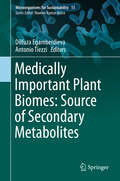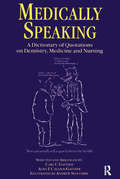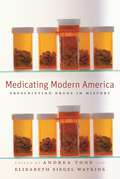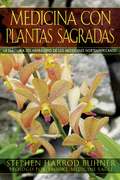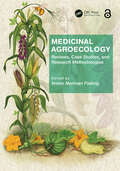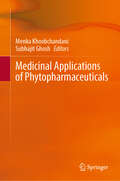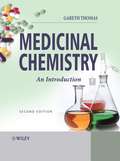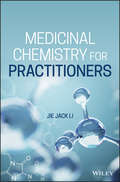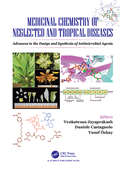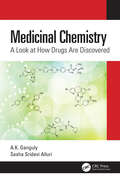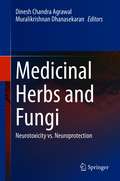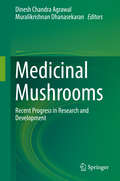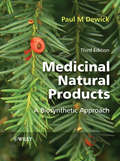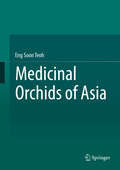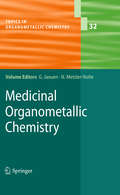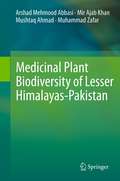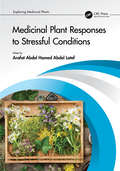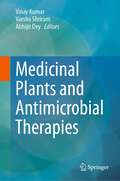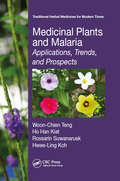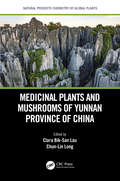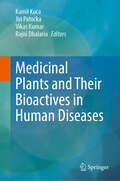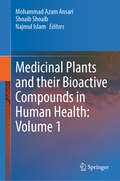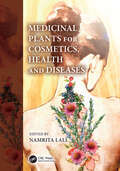- Table View
- List View
Medically Important Plant Biomes: Source of Secondary Metabolites (Microorganisms for Sustainability #15)
by Dilfuza Egamberdieva Antonio TiezziThis book provides insights into various aspects of medicinal plant-associated microbes, known to be a unique source of biological active compounds, including their biotechnological uses and their potential in pharmaceutical, agricultural and industrial applications. Featuring review papers and original research by leading experts in the field, it discusses medicinal plants and their interactions with the environment; medicinal plants as a source of biologically active compounds; medicinal plant-associated microbes (diversity and metabolites); their pharmaceutical, agricultural and industrial applications as well as their potential applications as plant growth stimulators and biocontrol agents. As such the book offers a valuable, up-to-date overview of the current research on medicinal plants, their ecology, biochemistry and associated biomes.
Medically Speaking: A Dictionary of Quotations on Dentistry, Medicine and Nursing
by C.C. GaitherMedically Speaking: A Dictionary of Quotations on Dentistry, Medicine, and Nursing contains over 1,500 quotes pertinent and especially illuminating to these disciplines. Here you will find quotations from the most famous to the unknown. Some are profound, some are witty, some are wise but none are frivolous. The extensive author and subject indexes
Medicating Modern America: Prescription Drugs in History
by Andrea Tone Elizabeth Siegel WatkinsWith Americans paying more than $200 billion each year for prescription pills, the pharmaceutical business is the most profitable in the nation. The popularity of prescription drugs in recent decades has remade the doctor/patient relationship, instituting prescription-writing and pill-taking as an integral part of medical practice and everyday life.Medicating Modern America examines the meanings behind this pharmaceutical revolution through the interconnected histories of eight of the most influential and important drugs: antibiotics, mood stabilizers, hormone replacement therapy, oral contraceptives, tranquilizers, stimulants, statins, and Viagra. All of these drugs have been popular, profitable, influential, and controversial, and the authors take a historical approach to studying their development, prescription, and consumption. This perspective locates the histories of prescription medicines in specific cultural contexts while revealing the extent to which contemporary debates about pharmaceutical drugs echo concerns voiced by Americans in the past.Exploring the rich and multi-faceted history of pharmaceutical drugs in the United States, Medicating Modern America unveils the untold stories behind America's pharmaceutical obsession.Contributors include: Robert Bud, Jennifer R. Fishman, Jeremy A. Greene, David Healy, Suzanne White Junod, Ilina Singh, Andrea Tone, and Elizabeth Siegel Watkins.
Medication Treatments for Nicotine Dependence
by Tony P. GeorgeDespite the prevalence of both pharmaceutical and behavioral approaches to encourage cessation, over a billion people still indulge in tobacco. Even in the U.S., where tobacco use is considered a clearly treatable and socially regrettable condition, a significant percentage of individuals remain resistant to treatment modalities. It is believed tha
Medicina con plantas sagradas: La sabiduría del herbalismo de los aborígenes norteamericanos
by Brooke Medicine Eagle Stephen Harrod BuhnerEl primer examen en profundidad de los fundamentos sagrados del mundo del herbalismo medicinal de los aborígenes norteamericanos • Revela cómo los chamanes y sanadores “hablan” con las plantas para descubrir sus propiedades medicinales • Incluye las oraciones y canciones medicinales vinculadas con el uso de cada una de las plantas examinadas A medida que los seres humanos evolucionaron en la Tierra, utilizaron plantas para todo lo imaginable --alimentos, armas, canastas, vestimentas, refugio y remedios de salud. En su libro Medicina con plantas sagradas, Stephen Harrod Buhner analiza la relación de larga data entre los pueblos aborígenes y las plantas y examina las técnicas y estados mentales que utilizan estas culturas para comunicarse con el mundo botánico. El autor explora la dimensión sagrada de las interacciones entre seres humanos y plantas --un territorio en el que los humanos experimentamos la comunicación con las plantas como expresiones del Espíritu. Con respecto a cada planta curativa descrita en el libro, el autor presenta sus usos medicinales, normas para su preparación y elementos ceremoniales como las oraciones y canciones medicinales vinculadas con el uso de la planta.
Medicinal Agroecology: Reviews, Case Studies and Research Methodologies
by Immo Norman FiebrigMedicinal Agroecology: Reviews, Case Studies, and Research Methodologies presents information on applications of ‘green therapies’ in restoration towards global sustainability. These practices connect the world of medicinal plants with ecologic farming practice, creating a compassionate socio-political worldview and heartfelt scientific research towards food sovereignty and a healthier future on planet Earth. The book communicates benefits of using plant-based solutions to manage the challenges of unsustainable practices in human healthcare, veterinary medicine, agriculture, forestry, and water management. The contributions introduce advances around plants and their active components to potentially treat disease, regulate dysfunction, and balance ecosystems. These practices are explored in further depth through three sections: POLICIES AND FRAMEWORKS, INSIGHTS AND OVERVIEWS, and CASE STUDIES AND RESEARCH METHODS. Edited by Immo Norman Fiebrig, Medicinal Agroecology: Reviews, Case Studies, and Research Methodologies appeals to those in various disciplines including agriculture and agroecology, healthcare, environmental sciences, and veterinary medicine.Chapters 3 and 9 of this book are freely available as a downloadable Open Access PDF at http://www.taylorfrancis.com under a Creative Commons [Attribution-Non Commercial-No Derivatives (CC-BY-NC-ND)] 4.0 license.
Medicinal Applications of Phytopharmaceuticals
by Menka Khoobchandani Subhajit GhoshThis book is devoted to phytopharmaceuticals and their role in managing human disorders. It also covers the biological role of herbal drugs and the latest research developments in herbal medicine. Divided into five parts, the book starts with a global perspective on phytopharmaceuticals providing insights into the lessons from the past to the future, followed by an overview of Ayurveda medicine, and the main isolation and extraction techniques of plant material. Parts 2 and 3 present the latest research on natural products and phytopharmaceuticals, in which the authors cover the current clinical research status on formulations containing medicinal plants, and an overview of nanomedicines. Particular attention is given to potential and current therapeutic applications of phytopharmaceuticals, including their role in the management of COVID-19, neurological disorders, and cancer therapy. Part 4 focuses on the biomedical applications of phytochemical-based formulations, and Part 5 outlines the role and benefits of nutraceuticals in human health. The final chapter of this book provides an overview of the main toxicity and regulatory aspects of herbal medicines. Collating the latest advances in phytopharmaceuticals and natural product drug discovery with a perspective on Ayurveda therapies, this book has broad appeal from scholars,and researchers to professionals interested in plant-based drug development and phytochemistry.
Medicinal Chemistry
by Gareth ThomasMedicinal Chemistry: An Introduction, Second Edition provides a comprehensive, balanced introduction to this evolving and multidisciplinary area of research. Building on the success of the First Edition, this edition has been completely revised and updated to include the latest developments in the field.Written in an accessible style, Medicinal Chemistry: An Introduction, Second Edition carefully explains fundamental principles, assuming little in the way of prior knowledge. The book focuses on the chemical principles used for drug discovery and design covering physiology and biology where relevant. It opens with a broad overview of the subject with subsequent chapters examining topics in greater depth.From the reviews of the First Edition:"It contains a wealth of information in a compact form" ANGEWANDTE CHEMIE, INTERNATIONAL EDITION"Medicinal Chemistry is certainly a text I would chose to teach from for undergraduates. It fills a unique niche in the market place." PHYSICAL SCIENCES AND EDUCATIONAL REVIEWS
Medicinal Chemistry Approaches to Personalized Medicine
by Raimund Mannhold Gerd Folkers Hugo Kubinyi Bruce Roth Karen LackeyEdited by two renowned medicinal chemists who have pioneered the development of personalized therapies in their respective fields, this authoritative analysis of what is already possible is the first of its kind, and the only one to focus on drug development issues.Numerous case studies from the first generation of "personalized drugs" are presented, highlighting the challenges and opportunities for pharmaceutical development. While the majority of these examples are taken from the field of cancer treatment, other key emerging areas, such as neurosciences and inflammation, are also covered.With its careful balance of current and future approaches, this handbook is a prime knowledge source for every drug developer, and one that will remain up to date for some time to come.From the content:* Discovery of Predictive Biomarkers for Anticancer Drugs* Discovery and Development of Vemurafenib* Targeting Basal-Cell Carcinoma* G-Quadruplexes as Therapeutic Targets in Cancer* From Human Genetics to Drug Candidates: An Industrial Perspective on LRRK2 Inhibition as a Treatment for Parkinson's Disease* Therapeutic Potential of Kinases in Asthma* DNA Damage Repair Pathways and Synthetic Lethality* Medicinal Chemistry in the Context of the Human Genomeand many more
Medicinal Chemistry for Practitioners
by Jie Jack LiPresenting both a panoramic introduction to the essential disciplines of drug discovery for novice medicinal chemists as well as a useful reference for veteran drug hunters, this book summarizes the state-of-the-art of medicinal chemistry. It covers key drug targets including enzymes, receptors, and ion channels, and hit and lead discovery. The book hen surveys a drug's pharmacokinetics and toxicity, with a solid chapter covering fundamental bioisosteres as a guide to structure-activity relationship investigations.
Medicinal Chemistry of Neglected and Tropical Diseases: Advances in the Design and Synthesis of Antimicrobial Agents
by Venkatesan Jayaprakash Daniele Castagnolo Yusuf OzkayMedicinal Chemistry of Neglected and Tropical Diseases: Advances in the Design and Synthesis of Antimicrobial Agents consolidates and describes modern drug discovery and development approaches currently employed to identify effective chemotherapeutic agents for the treatment of Neglected Tropical Diseases (NTDs) from a medicinal chemistry perspective. Chapters are designed to cater to the needs of medicinal chemists who work with chemotherapeutic developments for NTDs, as well as serve as a guide to budding medicinal chemists who wish to work in this area. It will introduce rational drug design approaches adopted in designing chemotherapeutics and validated targets available for the purpose.
Medicinal Chemistry: A Look at How Drugs Are Discovered
by A.K. Ganguly Sesha Sridevi AlluriMedicinal Chemistry: A Look at How Drugs Are Discovered is written for those who are interested in learning how drugs are discovered. Compared to other books on the market, this text takes a different approach by presenting the subject on chemical reaction mechanism terms, which ideally makes the subject matter more interesting and easier to comprehend. The authors describe the drug discovery process, from advancing an initial lead to the approval process, and include drug discovery sources. Additional features: Explains medicinal chemistry on chemical mechanism terms, allowing for a more interesting and easier to comprehend text Includes valuable insights toward the various pathways taken at pharmaceutical industries in drug discoveries Improved by including questions raised and suggestions made from students in the authors’ medicinal chemistry classes This book will benefit both upper level undergraduates and graduates studying in the fields of medicinal chemistry and drug discovery, as well as scientists working in the pharmaceutical industry.
Medicinal Herbs and Fungi: Neurotoxicity vs. Neuroprotection
by Dinesh Chandra Agrawal Muralikrishnan DhanasekaranThe ever-rising increase in the consumption of medicinal herbs and its products and its exposure in the human population have generated concerns about the potential neurotoxicity of several new and existing botanicals. This book offers an accurate, relevant, and comprehensive coverage of a wide variety of medicinal herbs and fungi affecting the central and peripheral nervous system. It includes review articles that thoroughly describe the benefits and adverse effects of some of the most commonly used medicinal herbs and fungi, and the pathophysiological mechanisms underlying them. The book provides an all-inclusive overview of the diverse aspects of medicinal herbs and fungi related to neurotoxicity and/or neuroprotection, ranging from discussions of cellular and molecular processes and pathology to clinical aspects. The rich compilation brings together thorough and extensive research updates on the advances in the field. The chapters have been contributed by the experienced and eminent academicians, researchers, and scientists working in the field across the globe.
Medicinal Mushrooms: Recent Progress in Research and Development
by Dinesh Chandra Agrawal Muralikrishnan DhanasekaranPresents the latest R & D information on medicinal mushrooms from diverse geographical locationsOffers comprehensive coverage of the most important application areas of medicinal mushroomsIncludes contributions by eminently experienced researchers in the field of medicinal mushrooms Medicinal mushrooms are increasingly gaining attention worldwide because of their pharmacologically bioactive compounds, which have demonstrated potent and unique clinical properties. Scientific studies carried out during the last decade have confirmed their efficacy in treating a wide range of diseases. Extracts and bioactive compounds obtained from mushrooms have been used medicinally as anticancer, immunomodulator, antibacterial, antiviral, anti-inflammatory, anti-atherosclerotic, neuroprotectant, cardioprotectant, antioxidant, and anti-hypoglycemic agents, and in stem cell-based therapies.Introducing readers to the latest developments in, and ongoing research efforts on, medicinal mushrooms, this book gathers articles contributed by eminent researchers in different disciplines and from around the globe. Highlighting the tremendous potential of mushrooms for the development of new drugs, the topics covered include but are not limited to: Recent progress in research on the pharmaceutical potential of medicinal mushrooms and prospects for their clinicalapplication Edible mushroom neuronutraceuticals: Basis of therapeutics Overview of therapeutic efficacy of mushrooms Mushrooms – a wealth of resources for prospective stem cell-based therapies Mushrooms as potential natural cytostatics
Medicinal Natural Products
by Paul M. DewickMedicinal Natural Products: A Biosynthetic Approach, Third Edition, provides a comprehensive and balanced introduction to natural products from a biosynthetic perspective, focussing on the metabolic sequences leading to various classes of natural products. The book builds upon fundamental chemical principles and guides the reader through a wealth of diverse natural metabolites with particular emphasis on those used in medicine.There have been rapid advances in biosynthetic understanding over the past decade through enzymology, gene isolation and genetic engineering. Medicinal Natural Products has been extended and fully updated in this new edition to reflect and explain these developments and other advances in the field. It retains the user-friendly style and highly acclaimed features of previous editions:a comprehensive treatment of plant, microbial, and animal natural products in one volumeextensive use of chemical schemes with annotated mechanistic explanationscross-referencing to emphasize links and similaritiesboxed topics giving further details of medicinal materials, covering sources, production methods, use as drugs, semi-synthetic derivatives and synthetic analogues, and modes of actionMedicinal Natural Products: A Biosynthetic Approach, Third Edition, is an invaluable textbook for students of pharmacy, pharmacognosy, medicinal chemistry, biochemistry and natural products chemistry.
Medicinal Orchids of Asia
by Eng Soon TeohThis unique book brings together a wealth of data on the botanical, ethno-medicinal and pharmacological aspects of over 500 species of Asian medicinal orchids. It starts off by explaining the role and limitations of complimentary and herbal medicines, and how traditional Asian medicine differs from Western, "scientific" medicine. The different Asian medical traditions are described, as well as their modes of preparing herbal remedies. The core of the book presents individual medicinal orchid species arranged by genera. Each species is identified by its official botanical name, synonyms, and local names. Its distribution, habitat and flowering season, uses and pharmacology are described. An overview sums up the research findings on all species within each genus. Clinical observations are discussed whenever available, and possible therapeutic applications are highlighted. The book closes with chapters on the conservation of medicinal orchids and on the role of randomized clinical trials.
Medicinal Organometallic Chemistry
by Gérard Jaouen Nils Metzler-NolteContents: Gérard Jaouen, Nils Metzler-Nolte : Introduction ; Stéphane GIBAUD and Gérard JAOUEN: Arsenic - based drugs: from Fowler's solution to modern anticancer chemotherapy; Ana M. Pizarro, Abraha Habtemariam and Peter J. Sadler : Activation Mechanisms for Organometallic Anticancer Complexes; Angela Casini, Christian G. Hartinger, Alexey A. Nazarov, Paul J. Dyson : Organometallic antitumour agents with alternative modes of action; Elizabeth A. Hillard, Anne Vessières, Gerard Jaouen : Ferrocene functionalized endocrine modulators for the treatment of cancer; Megan Hogan and Matthias Tacke : Titanocenes - Cytotoxic and Anti-Angiogenic Chemotherapy Against Advanced Renal-Cell Cancer; Seann P. Mulcahy and Eric Meggers : Organometallics as Structural Scaffolds for Enzyme Inhibitor Design; Christophe Biot and Daniel Dive : Bioorganometallic Chemistry and Malaria; Nils Metzler-Nolte : Biomedical applications of organometal-peptide conjugates; Roger Alberto : Organometallic Radiopharmaceuticals; Brian E. Mann : Carbon Monoxide - an essential signaling molecule.
Medicinal Plant Biodiversity of Lesser Himalayas-Pakistan
by Mushtaq Ahmad Mir Ajab Khan Arshad Mehmood Abbasi Muhammad ZafarThe Himalayan region is among the largest mountains systems of the world with uncounted unique medicinal plants resources. The lesser Himalayas ranges are the extension of Greater Himalayas. They have unique ecology, vegetation and diversity of medicinal flora due to tremendous variation in the altitude, climate and associated wildlife. The utilization of medicinal plants in medicine suffers from the fact that although plants are used to treat diseases, scientific evidence is lacking in many cases. Different societies of the world use the plants according to their own beliefs and knowledge and previous experiences. Their knowledge about the use of the plants is usually not known to the other world or science. This book provides a brief introduction of Lesser Himalayas, ethnobotanical aspects, marketing and anthropogenic pressure on medicinal flora. It comprises one hundred medicinal plant species including Pteridophytes, Gymnosperms and Angiosperms (Monocots and Dicots) along with their scientific description and traditional uses.
Medicinal Plant Responses to Stressful Conditions (Exploring Medicinal Plants)
by Abdel Latef, Arafat Abdel HamedMedicinal Plant Responses to Stressful Conditions discusses the effects of multiple biotic and abiotic stressors on medicinal plants. It features information on biochemical, molecular and physiological strategies used to mitigate or alleviate detrimental effects of biotic and abiotic stressors. The book contains chapters featuring medicinal plants of importance covering subjects including genomics, functional genomics, metabolomics, phenomics, proteomics and transcriptomics under biotic and abiotic stress of medicinal plants and their molecular responses. It suggests exogenous application of different types of stimulants to enhance medicinal plant production in such conditions. Features: Details all aspects of biotic and abiotic stressors in various important medicinal plant species. Chapters cover evidence-based approaches in the diagnosis and management of medicinal plants under stressful conditions. Includes information on ways to mitigate effects from biotic stress (diseases and pests) or abiotic stress (high salinity, drought, temperature extremes, waterlogging, wind, high light intensity, UV radiation, heavy metals and mineral deficiencies). A volume in the Exploring Medicinal Plants series, this book is an essential resource for plant scientists, botanists, environmental scientists and anyone with an interest in herbal medicine.
Medicinal Plants and Antimicrobial Therapies
by Vinay Kumar Varsha Shriram Abhijit DeyThis book serves as an excellent comprehensive material covering the current understandings and updates on antimicrobial resistance (AMR) and the use of medicinal plant resources for tackling it. Chapters cover important aspects of AMR and strategies to address this threatening issue with medicinal plants and their resources. One health perspectives for addressing AMR have been presented for the readers. Antimicrobial medicinal plant therapeutic resources including crude extracts, active fractions, pure molecules and essential oils, besides using them as functionalizing agents for nano-antimicrobials have been covered. Further, plant endophytes as a source of antimicrobial compounds have been discussed. Chapters cover both the bactericidal as well as resistance-reversal (or potentiating/ combinatorial therapies) potencies of medicinal plant resources. The book also focuses on how medicinal plant resources effectively target major determinants of AMR. Use of metabolomics in understanding and targeting AMR mechanisms and identifying potent phyto-therapeutics has been discussed as well. The book is a valuable read for both experienced and younger researchers working in the field of AMR and related fields in biomedicine, pharmacy, and clinical research.
Medicinal Plants and Malaria: Applications, Trends, and Prospects (Traditional Herbal Medicines For Modern Times Ser.)
by Woon-Chien Teng Ho Han Kiat Rossarin Suwanarusk Hwee-Ling KohMalaria is a potentially life-threatening disease that affects millions worldwide, especially in Sub-Saharan Africa. The recent emergence and spread of multidrug resistance in parts of Southeast Asia prompts the urgent need for novel and effective therapy against the disease. Medicinal Plants and Malaria: Applications, Trends, and Prospects highlig
Medicinal Plants and Mushrooms of Yunnan Province of China (Natural Products Chemistry of Global Plants)
by Clara Bik-San Lau and Chun-Lin LongAlthough many texts describe plants from China, the focus of this book is to draw on the rich culture and environment of medicinal plants and fungi/mushrooms of Yunnan Province. In fact, Yunnan Province covers two global hotspots of biodiversity, with the richest biological and cultural diversity in China. In particular, the Kunming Institute of Botany (KIB) of the Chinese Academy of Sciences (founded in 1938 and located in the capital city of Yunnan Province) has made great contributions in the fields of botany and phytochemistry, earning an international reputation. This book covers those medicinal plants and fungi/mushrooms specific to Yunnan Province, and is written mainly by KIB experts in this research field. Key Features: Distinct sections cover the breadth of the topic including resource availability (wildly grown or cultivated), sustainability, and distribution Discusses plant parts used for medicinal uses (the folklore, the ancient and modern uses) Describes the important natural products and the known pharmacologically active components Presents biological activities related to medicinal uses or clinical evidence Cover image: Shilin, the stone forest (eroded vertical pinnacles of limestone), landmark of Kunming, Yunnan.
Medicinal Plants and Their Bioactives in Human Diseases
by Vikas Kumar Kamil Kuca Jiri Patocka Rajni DhalariaMedicinal plants offer a promising alternative or complement to conventional therapies due to their natural origin, wide availability, and potential to provide a broad spectrum of pharmacological effects. Bioactive compounds derived from these plants, such as alkaloids, flavonoids, terpenoids, and phenolics, have shown diverse therapeutic activities, including antioxidant, anti-inflammatory, neuroprotective, and anti-cancer effects. The use of medicinal plants could provide safer, more holistic approaches to managing chronic and neurodegenerative diseases, reducing side effects and improving patient outcomes. By focusing on the applications of medicinal plants and their bioactive compounds, this book aims to explore the untapped potential of natural products in combating some of the most challenging diseases affecting human health today. It will serve as a comprehensive reference for researchers, healthcare professionals, and students interested in the therapeutic use of plant-based compounds and contribute to the advancement of integrative medicine.
Medicinal Plants and their Bioactive Compounds in Human Health: Volume 1
by Mohammad Azam Ansari Shoaib Shoaib Najmul IslamThis book delves into the vital role of plants and their bioactive compounds in human health, emphasizing their medicinal and nutritional significance. It highlights the growing concern of drug resistance in anticancer and antimicrobial medications, compelling clinicians, and researchers worldwide to seek alternative solutions. Plants offer a diverse array of compounds, serving as a promising resource for novel and safe drug candidates and potentially enhancing drug efficacy while being easily metabolized in the human body. Their cost-effectiveness, safety profile, and minimal side effects make them an ideal source for developing new drug regimens. The book aims to attract students, teachers, and researchers across various disciplines, covering topics such as biochemistry, pharmacology, botany, medicinal chemistry, virology, nutrition, clinical biochemistry, and biomedicine. The book will explore the medicinal and nutritional importance of plants and their products, showcasing their applications in medicine, industries, cosmetics, therapeutics, and preventive measures.
Medicinal Plants for Cosmetics, Health and Diseases
by Namrita Lall"A book is like a garden carried in the pocket." – Chinese proverb This Chinese proverb simply means: Reading helps strengthen one’s intellect, which correlates with the feeling one will have, once they have read this book. Medicinal Plants in Cosmetics, Health and Disease describes diseases and ailments occurring in individuals worldwide including acne, ageing, various cancers, eczema and other conditions. This book explains each disease and ailment, allowing the reader to gain a better perspective on misunderstood and underestimated assumptions accompanying the ailment or condition. Not only does this book present information on different diseases and ailments, it presents a variety of plants and plant-based compounds demonstrating potential health benefits. Features: Provides details on a broad range of diseases and conditions prevalent throughout the world. Includes information on how plant bioactives can aid in the prevention, treatment and management of diseases and conditions including cancer, tuberculosis and anti-coagulants, acne, wrinkle formation and eczema. Each chapter provides a list of plants and plant-based compounds found globally, demonstrating their potential in treating various diseases and conditions. This book is appropriate for individuals having interest in learning several potential health benefits using bioactives derived from medicinal plants and phytomedicine. About the Editor Namrita Lall is a professor of Medicinal Plant Sciences, DST/ NRF SARCHII Chair in Plant Health Products from IKS, and is based at the University of Pretoria, South Africa. In addition to this, she holds numerous appointments, including an adjunct faculty position at the University of Missouri, JSS College of Pharmacy, India and a senior research fellow at the Bio-Tech R&D Institute, Jamaica. She has an interest in investigating medicinal plants and evaluating their potential for pharmaceutical and cosmeceutical purposes.
